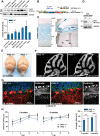PLD3 and spinocerebellar ataxia
- PMID: 30312375
- PMCID: PMC6202572
- DOI: 10.1093/brain/awy258
PLD3 and spinocerebellar ataxia
Figures


Comment in
-
Reply: PLD3 and spinocerebellar ataxia.Brain. 2018 Nov 1;141(11):e79. doi: 10.1093/brain/awy259. Brain. 2018. PMID: 30312384 No abstract available.
Comment on
-
Exome sequencing and network analysis identifies shared mechanisms underlying spinocerebellar ataxia.Brain. 2017 Nov 1;140(11):2860-2878. doi: 10.1093/brain/awx251. Brain. 2017. PMID: 29053796
References
-
- Gonzalez AC,, Schweizer M,, Jagdmann S,, Bernreuther C,, Reinheckel T,, Saftig P, et al. Unconventional trafficking of mammalian phospholipase D3 to lysosomes. Cell Rep 2018; 22: 1040–53. - PubMed
-
- Nibbeling EAR,, Duarri A,, Verschuuren-Bemelmans CC,, Fokkens MR,, Karjalainen JM,, Smeets C, et al. Exome sequencing and network analysis identifies shared mechanisms underlying spinocerebellar ataxia. Brain 2017; 140: 2860–78. - PubMed
-
- Pedersen KM,, Finsen B,, Celis JE,, Jensen NA. Expression of a novel murine phospholipase D homolog coincides with late neuronal development in the forebrain. J Biol Chem 1998; 273: 31494–504. - PubMed
Publication types
MeSH terms
Grants and funding
LinkOut - more resources
Full Text Sources
Molecular Biology Databases

